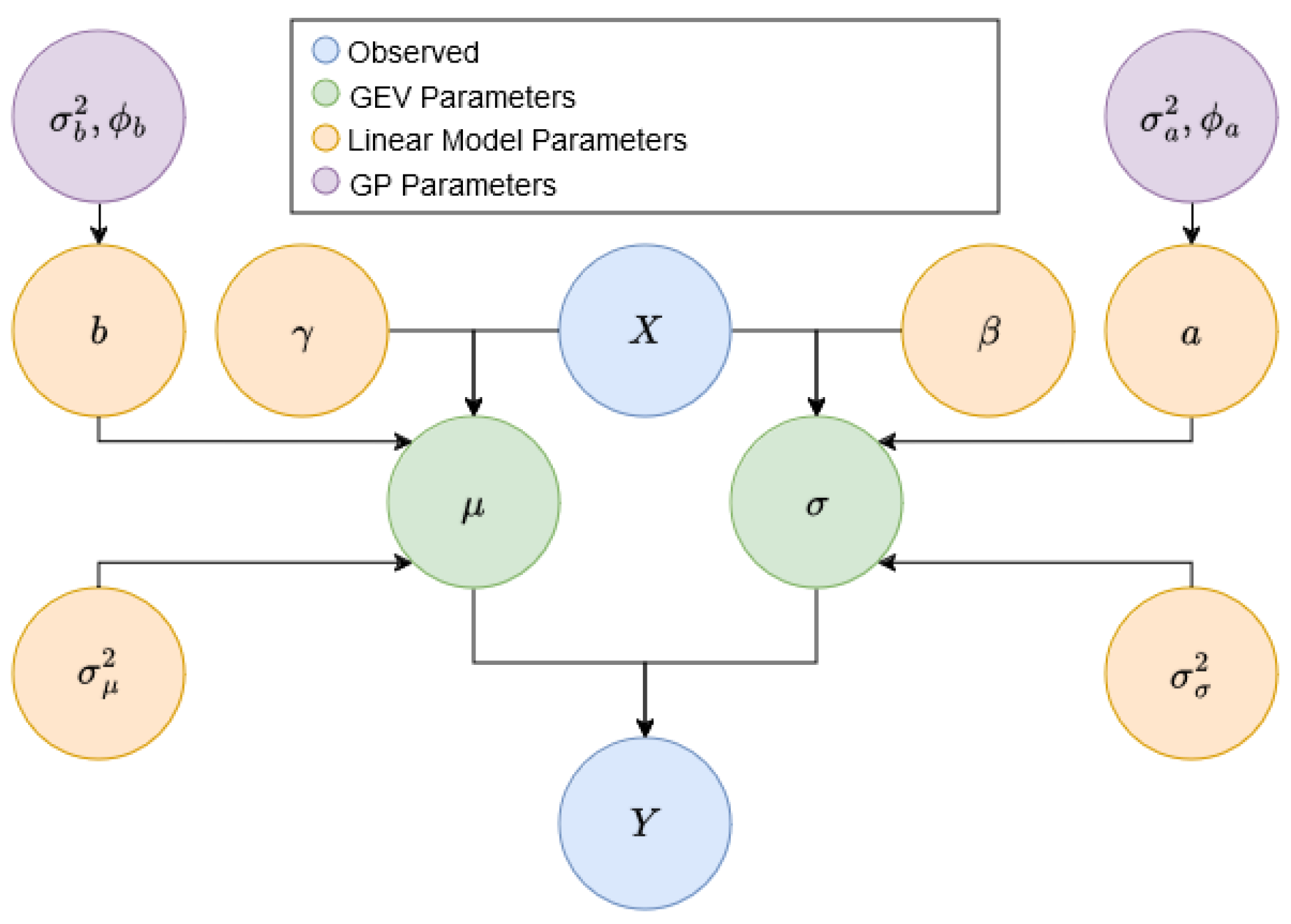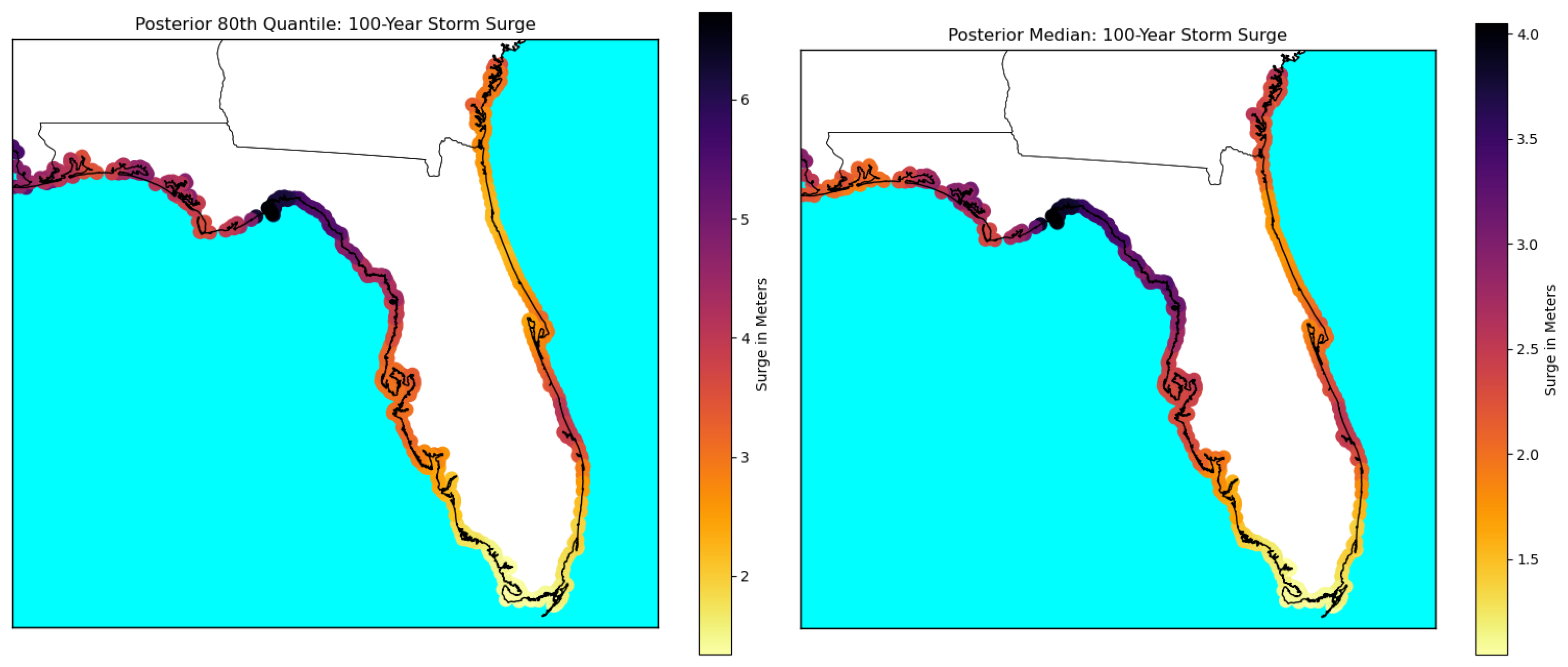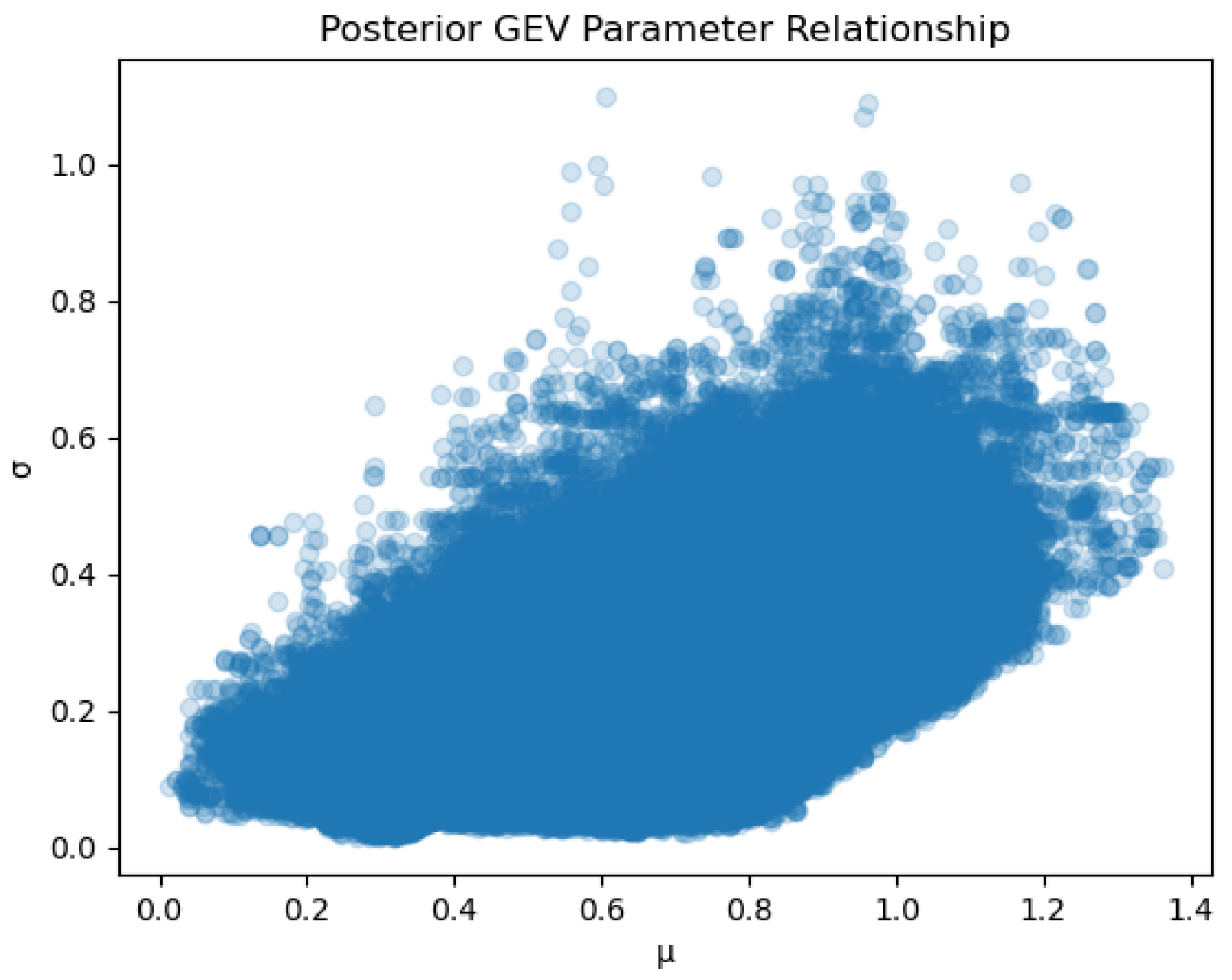Generalizable Storm Surge Risk Modeling
Abstract
1. Introduction
2. Methodology
Gibbs Sampling Algorithm
| Algorithm 1 Gibbs sampling algorithm |
| Initialize: Set hyperparameters: while do ▹ Gibbs update for ▹ Gibbs update for ▹ Gibbs update for ▹ Gibbs update for ▹ Gibbs update for a ▹ Gibbs update for b ▹ Metropolis–Hastings for for do if then end if end for ▹ Metropolis–Hastings for for do if then end if end for ▹ Metropolis–Hastings for if then end if MH for , same as above but with b instead of a ▹ Metropolis–Hastings for ▹ Metropolis–Hastings for if then end if MH for , same as above but with b instead of a ▹ Metropolis–Hastings for end while |
3. Application Details and Results
4. Validation
5. Discussion
Author Contributions
Funding
Data Availability Statement
Acknowledgments
Conflicts of Interest
References
- Wahl, T.; Jain, S.; Bender, J.; Meyers, S.D.; Luther, M.E. Increasing risk of compound flooding from storm surge and rainfall for major US cities. Nat. Clim. Chang. 2015, 5, 1093–1097. [Google Scholar] [CrossRef]
- Wahl, T.; Haigh, I.D.; Nicholls, R.J.; Arns, A.; Dangendorf, S.; Hinkel, J.; Slangen, A.B.A. Understanding extreme sea levels for broad-scale coastal impact and adaptation analysis. Nat. Commun. 2017, 8, 16075. [Google Scholar] [CrossRef] [PubMed]
- Boumis, G.; Moftakhari, H.R.; Moradkhani, H. Storm surge hazard estimation along the US Gulf Coast: A Bayesian hierarchical approach. Coast. Eng. 2023, 185, 104371. [Google Scholar] [CrossRef]
- Gelman, A.; Carlin, J.B.; Stern, H.S.; Dunson, D.B.; Vehtari, A.; Rubin, D.B. Bayesian Data Analysis, 3rd ed.; Texts in statistical science series; CRC Press, Taylor and Francis Group: Boca Raton, FL, USA; London, UK; New York, NY, USA, 2014. [Google Scholar]
- Fei-Fei, L.; Perona, P. A Bayesian hierarchical model for learning natural scene categories. In Proceedings of the 2005 IEEE Computer Society Conference on Computer Vision and Pattern Recognition (CVPR’05), San Diego, CA, USA, 20–26 June 2005; Volume 2, pp. 524–531, ISSN: 1063-6919. [Google Scholar] [CrossRef]
- Beck, N.; Genest, C.; Jalbert, J.; Mailhot, M. Predicting extreme surges from sparse data using a copula-based hierarchical Bayesian spatial model. Environmetrics 2020, 31, e2616. [Google Scholar] [CrossRef]
- Calafat, F.M.; Marcos, M. Probabilistic reanalysis of storm surge extremes in Europe. Proc. Natl. Acad. Sci. USA 2020, 117, 1877–1883. [Google Scholar] [CrossRef] [PubMed]
- Kotz, S.; Nadarajah, S. Extreme Value Distributions: Theory and Applications; World Scientific: Singapore, 2000. [Google Scholar]
- Blanchet, J.; Marty, C.; Lehning, M. Extreme value statistics of snowfall in the Swiss Alpine region. Water Resour. Res. 2009, 45. [Google Scholar] [CrossRef]
- Cotter, J. Margin exceedences for European stock index futures using extreme value theory. J. Bank. Financ. 2001, 25, 1475–1502. [Google Scholar] [CrossRef]
- Rasmussen, C.E.; Williams, C.K.I. Gaussian Processes for Machine Learning, 3rd ed.; Adaptive Computation and Machine Learning; MIT Press: Cambridge, MA, USA, 2008. [Google Scholar]
- He, Q.; Huang, H.H. A framework of zero-inflated Bayesian negative binomial regression models for spatiotemporal data. J. Stat. Plan. Inference 2024, 229, 106098. [Google Scholar] [CrossRef]
- Huang, H.H.; He, Q. Statistical modeling of Peromyscus maniculatus (deer mouse) amounts per trap with spatiotemporal data. Jpn. J. Stat. Data Sci. 2023, 6, 847–860. [Google Scholar] [CrossRef]
- Banerjee, S.; Gelfand, A.E.; Finley, A.O.; Sang, H. Gaussian Predictive Process Models for Large Spatial Data Sets. J. R. Stat. Soc. Ser. B Stat. Methodol. 2008, 70, 825–848. [Google Scholar] [CrossRef] [PubMed]
- Ghosh, S.; Mallick, B.K. A hierarchical Bayesian spatio-temporal model for extreme precipitation events. Environmetrics 2011, 22, 192–204. [Google Scholar] [CrossRef]
- Huang, H.H.; Yu, F.; Li, K.; Zhang, T. Frechet Sufficient Dimension Reduction for Metric Space-Valued Data via Distance Covariance. arXiv 2024, arXiv:2412.13122. [Google Scholar]
- Harris, C.R.; Millman, K.J.; van der Walt, S.J.; Gommers, R.; Virtanen, P.; Cournapeau, D.; Wieser, E.; Taylor, J.; Berg, S.; Smith, N.J.; et al. Array programming with NumPy. Nature 2020, 585, 357–362. [Google Scholar] [CrossRef] [PubMed]
- Virtanen, P.; Gommers, R.; Oliphant, T.E.; Haberland, M.; Reddy, T.; Cournapeau, D.; Burovski, E.; Peterson, P.; Weckesser, W.; Bright, J.; et al. SciPy 1.0: Fundamental algorithms for scientific computing in Python. Nat. Methods 2020, 17, 261–272. [Google Scholar] [CrossRef] [PubMed]
- Center for Operational Oceanographic Products and Services. Tides/Water Levels. 2024. Available online: https://tidesandcurrents.noaa.gov/products.html (accessed on 7 December 2024).
- Hersbach, H.; Bell, B.; Berrisford, P.; Hirahara, S.; Horányi, A.; Muñoz-Sabater, J.; Nicolas, J.; Peubey, C.; Radu, R.; Schepers, D.; et al. The ERA5 global reanalysis. Q. J. R. Meteorol. Soc. 2020, 146, 1999–2049. [Google Scholar] [CrossRef]



| Regression Coefficient | 95% C.I. |
|---|---|
| Intercept | |
| Sea Level Pressure | |
| Wind | |
| Precipitation |
| Parameter | 95% C.I. |
|---|---|
| Parameter | True Value | 95% CI/Coverage Proportion | |
|---|---|---|---|
| Vector | 90% | ||
| Vector | 95% | ||
| Vector | 100% | ||
| Vector | 100% | ||
| Vector | 95% | ||
| b | Vector | 80% | |
| 0.2 | [0.53, 2.5] | ||
| 0.2 | [0.12, 1.05] | ||
| 0.5 | [0.04, 1.56] | ||
| 0.6 | [0.012, 1.86] | ||
| 60 | [10.7, 230.8] | ||
| 90 | [5.23, 200.6] | ||
| Location | MLE | Our BHM | True |
| 1, Sim | [7.01, 9.05] | [7.36, 9.76] | 8.5 |
| 3, Sim | [−300,000, 618,000] | [12,000, 2,030,000] | 166,000 |
| 10, Sim | [24.4, 144] | [50.6, 214] | 88 |
| Naples | [1.2, 2.88] | [1.41, 2.67] | |
| Clearwater | [1.15, 2.72] | [1.60, 3.33] | |
| Eastpoint | [1.24, 4.01] | [1.15, 2.73] | |
Disclaimer/Publisher’s Note: The statements, opinions and data contained in all publications are solely those of the individual author(s) and contributor(s) and not of MDPI and/or the editor(s). MDPI and/or the editor(s) disclaim responsibility for any injury to people or property resulting from any ideas, methods, instructions or products referred to in the content. |
© 2025 by the authors. Licensee MDPI, Basel, Switzerland. This article is an open access article distributed under the terms and conditions of the Creative Commons Attribution (CC BY) license (https://creativecommons.org/licenses/by/4.0/).
Share and Cite
Scott, M.; Huang, H.-H. Generalizable Storm Surge Risk Modeling. Mathematics 2025, 13, 486. https://doi.org/10.3390/math13030486
Scott M, Huang H-H. Generalizable Storm Surge Risk Modeling. Mathematics. 2025; 13(3):486. https://doi.org/10.3390/math13030486
Chicago/Turabian StyleScott, Mahlon, and Hsin-Hsiung Huang. 2025. "Generalizable Storm Surge Risk Modeling" Mathematics 13, no. 3: 486. https://doi.org/10.3390/math13030486
APA StyleScott, M., & Huang, H.-H. (2025). Generalizable Storm Surge Risk Modeling. Mathematics, 13(3), 486. https://doi.org/10.3390/math13030486






